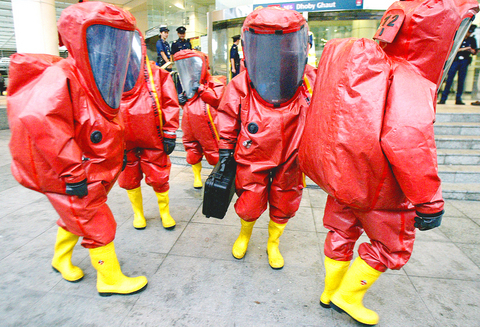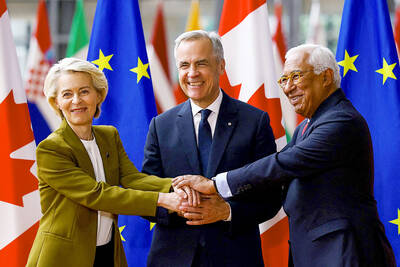Hot weather. Crowded communities. Weak public health systems. The vulnerability of much of Southeast Asia to infectious diseases such as SARS and bird flu suggests that a bioterror attack could be devastating, experts say.
While the likelihood of an attack is considered low, the alleged interest of some regional Islamic militants in acquiring disease-causing agents or toxins means it cannot be ruled out. Any nation allied with the US is a potential target, intelligence analysts believe.
This coming week, Interpol hosts a workshop in Singapore on the threat of bioterrorism for senior police and government officials from 37 countries around Asia. A similar conference was held in South Africa in November, and another is to be held in Chile later this year.

PHOTO: AP
Starting on Monday, the delegates in Singapore will discuss lab security, forensic work and laws designed to prevent bioterrorism, as well assess how to respond to a simulated bioterrorist attack.
The US, which adopted a Bioterrorism Act in 2002 after anthrax sent through the mail killed five people, wants Asian nations to craft similar laws that mandate tighter controls on access to biological agents and toxins.
So far, militants in Southeast Asia have used conventional terror weapons. Jemaah Islamiyah, a group linked to al-Qaeda, is accused of deadly bombings, including blasts on the Indonesian resort island of Bali in 2002 and 2005.
The Abu Sayyaf group also carries out bomb attacks and kidnappings in the Philippines.
But detained suspects include Yazid Sufaat, a former Malaysian army captain and a US-trained biochemist linked to al-Qaeda's attempts to produce chemical and biological arms. Yazid was arrested in late 2001 as he returned to Malaysia from Afghanistan.
A Jemaah Islamiyah manual discovered in the Philippines in 2003 indicates interest in acquiring chemical and biological agents for use in a terrorist attack, said Rohan Gunaratna, a terrorism expert based in Singapore.
"It demonstrates serious intent, but not capability," Gunaratna said.
Terrorists need expertise to acquire pathogens from nature, and transform them into a potent weapon. Japan's Aum Shinrikyo group, whose homemade sarin chemical agent killed 12 people in 1995, was unable to isolate a virulent strain of anthrax.
But more Asian countries are pursuing biomedical research, which can lead to new treatments, and concern is growing that laboratory materials could fall into the wrong hands.
"The central problem of preventing bioterrorism is, how do police do what they have to do without getting in the way of legitimate bioscience? If somebody's working with anthrax, are they a good guy or a bad guy?" said Barry Kellman, a weapons control expert at the DePaul University College of Law in Chicago.
Kellman said Thailand, Malaysia and Vietnam are among countries that need to reinforce laws to cope with the threat of bioterrorism.
A weak regulatory environment in China has raised US concerns about proliferation of technologies that could be used to make biological weapons. Washington says North Korea has a biological weapons program, though concern about proliferation by the communist country has focused on nuclear activities.
Southeast Asia would be vulnerable to an attack because many countries are prone to the fast spread of infections and epidemics, according to health officials. Anthrax is not contagious, but smallpox is. Agents can be spread by food contamination, or by infected mosquitoes and rats.
Singapore, a close US ally, views its 2003 fight against SARS, or severe acute respiratory syndrome, as preparation for a bioterrorist attack. Experts used computers to track people who might have had contact with patients of the disease, which spread from Asia across the world, killing nearly 800 people.
Last year, Singapore passed a law that imposes life in prison on anyone who uses biological agents and toxins for a "non-peaceful purpose."
But placing controls on "dual use" technology makes it hard to prevent terrorists from seeking equipment to make biological weapons, said Manjunath K.S. of the Institute of Peace and Conflict Studies in New Delhi, India. For example, he said, a machine that ferments molasses to produce beer could also be used to make deadly toxins.
"You can have industries that unintentionally give it out to customers, who may have other designs," he said.

Drug lord Jose Adolfo Macias Villamar, alias “Fito,” was Ecuador’s most-wanted fugitive before his arrest on Wednesday, more than a year after he escaped prison from where he commanded the country’s leading criminal gang. The former taxi driver turned crime boss became the prime target of law enforcement early last year after escaping from a prison in the southwestern port of Guayaquil. Ecuadoran President Daniel Noboa’s government released “wanted” posters with images of his face and offered US$1 million for information leading to his capture. In a country plagued by crime, members of Fito’s gang, Los Choneros, have responded with violence, using car

The team behind the long-awaited Vera Rubin Observatory in Chile yesterday published their first images, revealing breathtaking views of star-forming regions as well as distant galaxies. More than two decades in the making, the giant US-funded telescope sits perched at the summit of Cerro Pachon in central Chile, where dark skies and dry air provide ideal conditions for observing the cosmos. One of the debut images is a composite of 678 exposures taken over just seven hours, capturing the Trifid Nebula and the Lagoon Nebula — both several thousand light-years from Earth — glowing in vivid pinks against orange-red backdrops. The new image

Canada and the EU on Monday signed a defense and security pact as the transatlantic partners seek to better confront Russia, with worries over Washington’s reliability under US President Donald Trump. The deal was announced after a summit in Brussels between Canadian Prime Minister Mark Carney and European Commission President Ursula von der Leyen and European Council President Antonio Costa. “While NATO remains the cornerstone of our collective defense, this partnership will allow us to strengthen our preparedness ... to invest more and to invest smarter,” Costa told a news conference. “It opens new opportunities for companies on both sides of the

OVERHAUL: The move would likely mark the end to Voice of America, which was founded in 1942 to counter Nazi propaganda and operated in nearly 50 languages The parent agency of Voice of America (VOA) on Friday said it had issued termination notices to more than 639 more staff, completing an 85 percent decrease in personnel since March and effectively spelling the end of a broadcasting network founded to counter Nazi propaganda. US Agency for Global Media (USAGM) senior advisor Kari Lake said the staff reduction meant 1,400 positions had been eliminated as part of US President Donald Trump’s agenda to cut staffing at the agency to a statutory minimum. “Reduction in Force Termination Notices were sent to 639 employees at USAGM and Voice of America, part of a